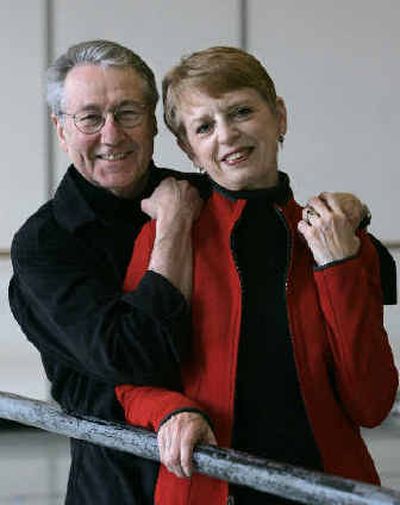Last dance

SEATTLE – The sole of Kent Stowell’s sneaker squeaks partway through a pirouette as he shows his dancers an improvised set of moves to practice.
With his wire-rimmed glasses, polo shirt and casual slacks, he looks more like the guy next door than the resident choreographer and co-artistic director of Seattle’s Pacific Northwest Ballet.
When it’s Francia Russell’s turn to teach, the class is carefully scripted. Dressed in black and wearing low-heeled rehearsal shoes, she’s the classical half of the husband-and-wife team that has spent nearly three decades transforming a fledgling dance troupe into a world-class company.
Steeped in the tradition of the late New York City Ballet legend George Balanchine, Russell is normally a stickler for technique. Hours away from opening night, she gives dancers a bit of a reprieve – but still watches them like a hawk, as if taking mental notes for some future lesson.
As the final days of their careers approach, Stowell and Russell say it’s these moments with their dancers that they’ll miss the most.
“Helping them realize their potential is the thing that I’ve enjoyed … well, more than anything in life except my family,” says Russell, 67, who also directs the ballet’s school.
“Silver Lining,” the last production Stowell and Russell will stage before retiring, opens tonight and runs through June 11 at McCaw Hall. (For ticket information, see www.pnb.org or call 206-441-2424.)
With their three young boys in tow, they came to Seattle from the Frankfurt Ballet in 1977, eager to turn a small-time company into a powerhouse, staging ambitious works both at home and on tour.
Twenty-eight years later, critics and colleagues say they’ve succeeded.
“They have really pioneered the whole post-Balanchine … nationalization of ballet. It used to be that you had to go to New York to see this kind of ballet,” said Arlene Croce, a dance critic for The New Yorker magazine from the early 1970s to the late 1990s.
One of their first big successes was Stowell’s full-length production of “Swan Lake” in 1981.
“It was spectacular visually, and I think the orchestra really rose to the challenge. The musical values of the company have always been paramount,” says Melinda Bargreen, a music critic for The Seattle Times.
Stowell’s rendition of “The Nutcracker” won rave reviews when it premiered in 1983. Since then, the company has performed it before more than 1.5 million people in Seattle and several other cities.
Russell and Stowell started out with 18 dancers, 1,200 subscribers, very little money and many skeptics. Some wondered why anyone would bother trying to build a big-shot ballet company in the land of bookworms and backpackers.
Performances were far from polished in the early days. Their budget was so tight, they couldn’t afford to replace a slippery floor.
“Every time the dancers went on stage, they’d slip and fall, so everybody thought they were just a bunch of bad dancers, and it was really the floor,” says Stowell, 66.
“We had one board member who called us The Falling Down Ballet Company, and finally we just said, ‘Of course, they’re going to fall down. The paint is worn out. It’s slippery, and we’ve got to get a new floor!’ “
The floor was eventually replaced.
Today, the ballet has an annual budget of $17 million and about 50 company dancers. Some 200,000 people come to see the PNB perform in a typical season, 11,000 of them season subscribers. More than 850 students attend the ballet’s school, from tiny tots to professionals.
It all took tireless work: creating a curriculum for the school, training dancers, meeting with board members, trying to raise the ballet’s profile and getting more people interested in going out to performances.
“You have to live it and breathe it every day of your life, and when you consider they were bringing up three sons as they were living and breathing it, it’s pretty remarkable,” says Barbara Horgan, who served as Balanchine’s personal assistant for nearly 20 years.
The affable couple say they kept their cool by focusing on bringing out the best in their dancers.
“We never felt like, ‘This isn’t going to work,’ ” Stowell says. “We always felt like there was something more to achieve.”
When she was a child, people would point at Russell’s pigeon toes and bony knees and tell her she didn’t have what it takes to be a dancer. She proved everyone wrong and says those rough, early days taught her to be compassionate with her students – and patient.
“We always saw potential,” Russell says. “We could see where we thought they could go in time, and we were happy to work with them, make them better dancers, and, of course, it did happen.”
Louise Nadeau, a principal dancer who joined the ballet 15 years ago, says Russell and Stowell have made the company well-rounded by guiding them from different perspectives.
“She’s very meticulous about the technical aspects of our dancing,” Nadeau says. “He forces us out of our comfort zone.”
Peter Boal, a longtime New York City Ballet principal, will become the PNB’s artistic director in July. He raves about the dancers he’s getting. He taught about a dozen of them at the School of American Ballet.
“The dancers are so well-trained, so versatile and also so well-rounded,” says Boal, 39. “That’s what the top companies in the world would strive for, but so few can achieve it.”
Boal also will serve as the school’s director and says he has no plans for big changes. He’s asked Stowell and Russell to stay involved with the ballet.
When they talk about leaving, their voices sometimes hang heavy with emotion. Yet they give off no sign of doubting it’s the right time to step aside and let Boal take over.
“He believes anything and everything is possible,” Russell says. “And that’s what the Pacific Northwest Ballet needs right now – that youthful vision that won’t be denied.”